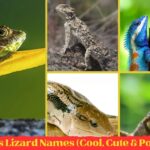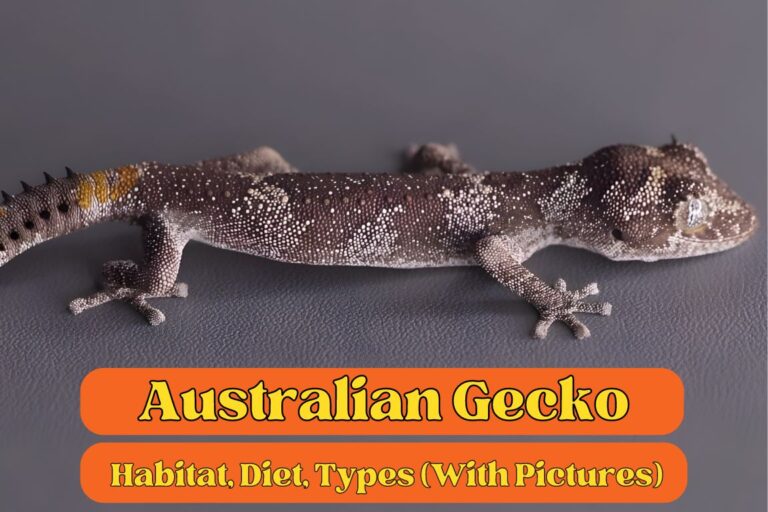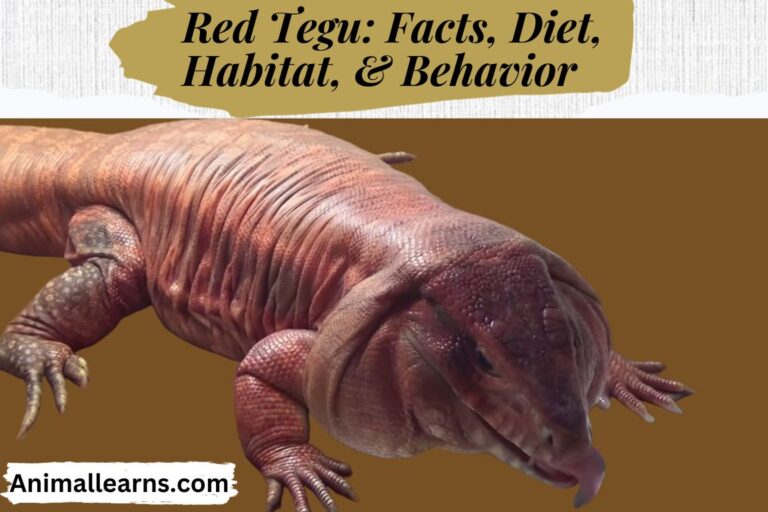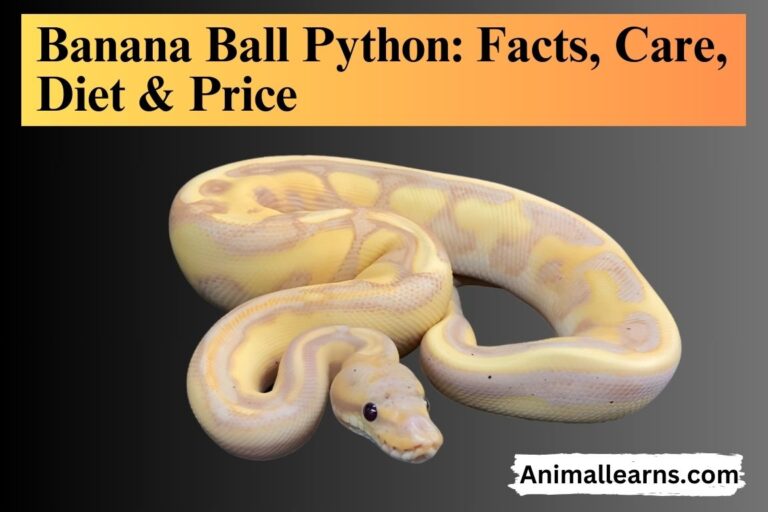Discover Top 15 Geckos In Florida
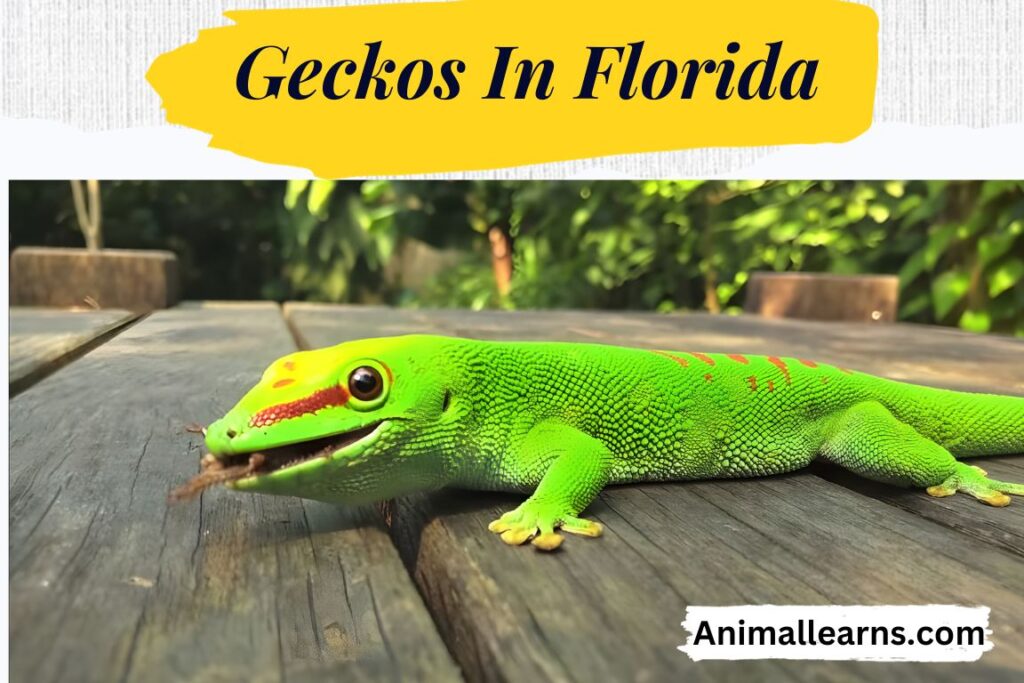
Geckos in Florida intriguing patterns and nimble motions lend a magical touch to the many ecosystems of the Sunshine State.
The fauna of Florida is among the most colorful, varied, and breathtaking in the world—not just in the US! This is mostly because of Florida’s semi-tropical climate, which offers ideal circumstances for a diverse array of flora and fauna.
The reptiles of the Sunshine State are particularly interesting, with Florida’s about twelve different species of geckos being the most unusual and visually appealing.
There is only one species of gecko native to Florida, and that is the Florida reef gecko. Remarkably, all other species of Florida gecko have been introduced to the area, mostly by uninvited human eviction from their native habitats in Asia and Africa.
It’s great news that they are not toxic. In actuality, geckos do not pose a threat to humans or animals. They may bite, and some larger varieties may pierce the flesh, although they are calm if your pet attacks them.
Today, you’ll learn about 15 different kinds of geckos in Florida.
Gecko In Florida List
Contents
- 1 Gecko In Florida List
- 1.1 Common House Geckos In Florida
- 1.2 Asian Flat-Tailed House Gecko
- 1.3 Ocellated Gecko (Sphaerodactylus argus)
- 1.4 Madagascar Giant Day Gecko (Phelsuma grandis)
- 1.5 Yellow-Headed Gecko (Gonatodes albogularis)
- 1.6 Tropical House Gecko (Hemidactylus mabouia)
- 1.7 Ashy Gecko (Sphaerodactylus elegans)
- 1.8 White-Spotted Wall Gecko (Tarentola annularis)
- 1.9 Flat-Tailed House Gecko (Hemidactylus platyurus)
- 1.10 Tokay Gecko (Gekko gecko)
- 1.11 Mediterranean House Gecko (Hemidactylus turcicus)
- 1.12 Bibron’s Thick-Toed Gecko (Chondrodactylus bibronii)
- 1.13 Florida Reef Gecko
- 1.14 Mourning Gecko (Hemidactylus lugubris)
- 1.15 Golden Gecko
- 2 FAQs
- Common House Gecko
- Asian Flat-Tailed House Gecko
- Ocellated Gecko (Sphaerodactylus argus)
- Madagascar Giant Day Gecko (Phelsuma grandis)
- Yellow-Headed Gecko (Gonatodes albogularis)
- Tropical House Gecko (Hemidactylus mabouia)
- Ashy Gecko (Sphaerodactylus elegans)
- White-Spotted Wall Gecko (Tarentola annularis)
- Flat-Tailed House Gecko (Hemidactylus platyurus)
- Tokay Gecko (Gekko gecko)
- Mediterranean House Gecko
- Bibron’s Thick-Toed Gecko (Chondrodactylus bibronii)
- Florida Reef Gecko
- Mourning Gecko
- Golden Gecko
Common House Geckos In Florida
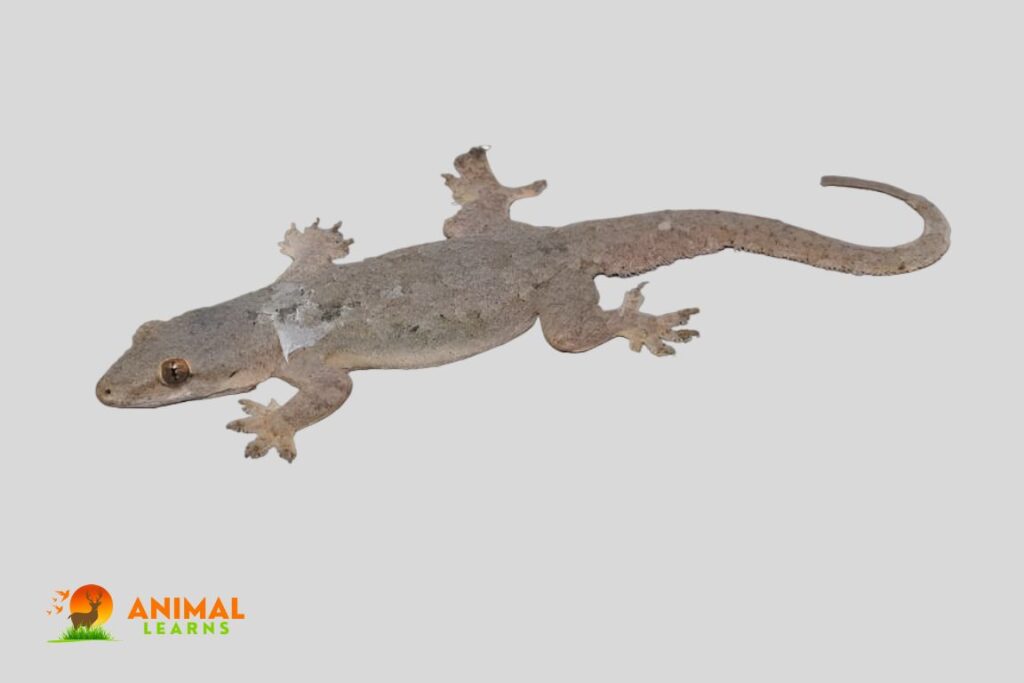
Originally from Asia and Southeast Asia, the common house gecko (Hemidactylus frenatus) is a small, nocturnal lizard that can now be found in tropical and subtropical regions of the world, including the United States, South America, Africa, and Australia.
Common house geckos have smooth, granular scales covering their skin, and their bodies are typically gray or brown with darker spots and stripes on their backs. They also have a slender tail and a long tail.
Usually with dark stripes or patches, the coloring is brown or gray. Light lines pass through the pupil of this species.
Asian Flat-Tailed House Gecko
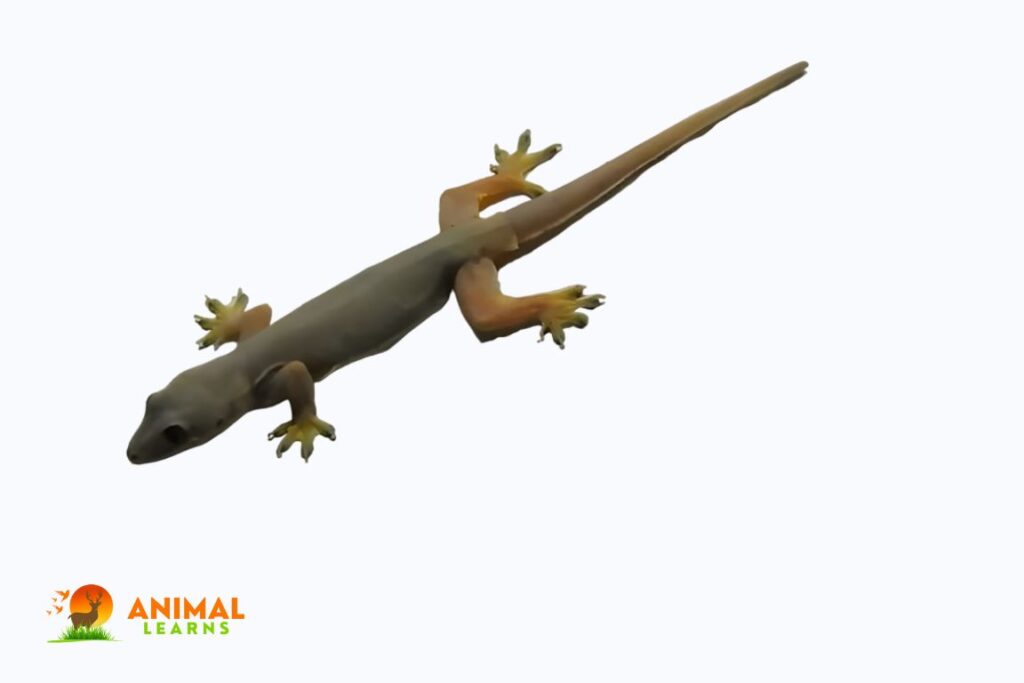
Given that its natural habitats are mostly in Southeast Asia, this long, thin gecko is sometimes occasionally referred to as the Asian house gecko. Similar to almost all of the lizards on this list, this species is native to South Florida.
This gecko falls midway in the center of the size spectrum. The typical length of a flat-tailed house gecko is between 4 and 6 inches. As its name implies, it has a relatively thin and flat body and tail. Its body is mostly light gray, with tan, brown, and dark grey patterns scattered throughout.
The lizard’s sophisticated camouflage is facilitated by these marks, as it mixes in perfectly with the leaf litter and tree bark.
Strangely enough, this species has gained popularity in the pet sector, especially with novice reptile enthusiasts searching for a low-maintenance scaly friend.
Flat-tailed house geckos are cheap, need little maintenance, and may live very peacefully in relatively tiny cages, despite their poor handling tolerance.
It is frequently mistaken for other house geckos, including the Mediterranean and tropical house geckos, due to their similar size and look.
Ocellated Gecko (Sphaerodactylus argus)
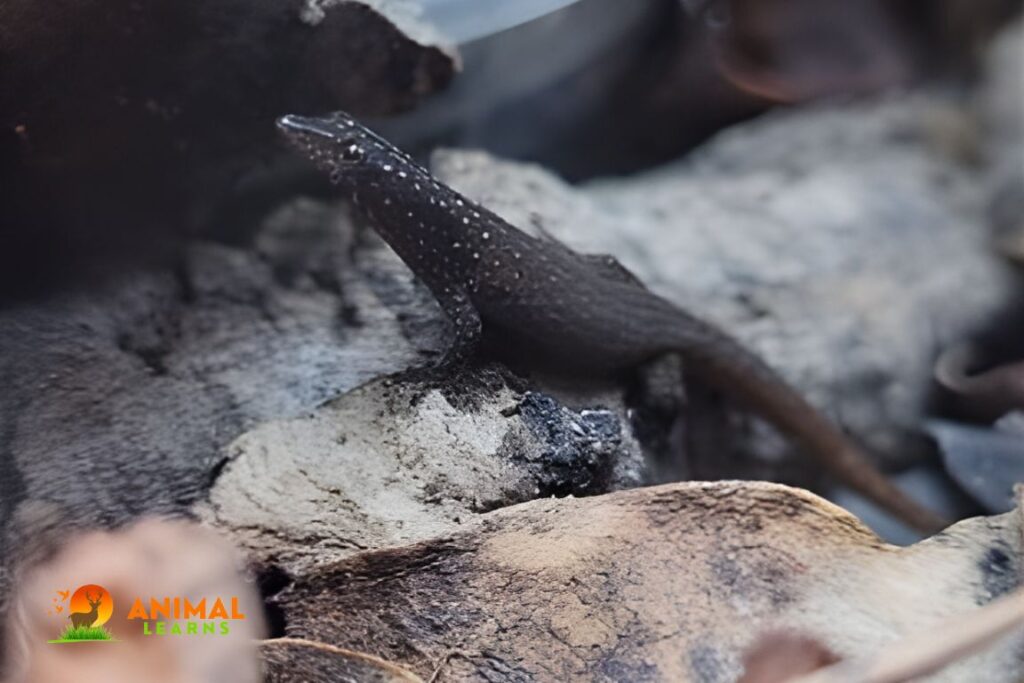
The ocellated gecko, commonly referred to as the stippled or ocellated sphaero, comes next. This species is unique to Jamaica, but it has spread to Cuba, the Bahamas, and of course, South Florida, especially the Florida Keys, where populations have been formed.
Ocellated geckos are very little lizards, measuring just 2 to 2.5 inches in length. Their hue is generally dark brown with little circular dots that might be white or light tan. The gecko’s body is covered with these patches from nose to tail.
The gecko has a rather long and pointed snout, and its eyes are huge, spherical, and brown. They are primarily olive or brown in hue, although occasionally they feature small white dots or no pattern at all.
The ocellated gecko is actually somewhat of an outlier among geckos, despite their seemingly unremarkable appearance.
Even though the majority of the species in the Gekkota infraorder are extremely arboreal, the ocellated gecko is mostly terrestrial and can climb rather well, keeping low to the ground most of the time.
Furthermore, the ocellated gecko is a diurnal species, in contrast to most other gecko species that are nocturnal. This indicates that it is more active during the day and sleeps at night.
Madagascar Giant Day Gecko (Phelsuma grandis)

The Madagascar huge day gecko, as its name suggests, is a diurnal species that is unique to Madagascar and among the biggest in the world. From nose to tail, these vivid green geckos often measure between 9 and 11 inches in length. Generally speaking, guys are somewhat heavier and longer than females.
This robust, resilient lizard has spread to a few locations distant from its home country, including Florida and Hawaii in the United States, as well as the island of Mauritius.
As a result of habitat loss, they are starting to live in increasingly urban areas. When vying for mates and other resources, these lizards—especially the males—become extremely hostile and possessive.
Even though this specific day gecko has many characteristics with other species, such as the gold dust day gecko, it is simple to tell them apart if you know what to look for.
The primary distinction is size: MGD geckos are noticeably bigger in weight and length than any other day geckos. Another distinctive feature of the species is the red marks around its nose and eyes.
Yellow-Headed Gecko (Gonatodes albogularis)
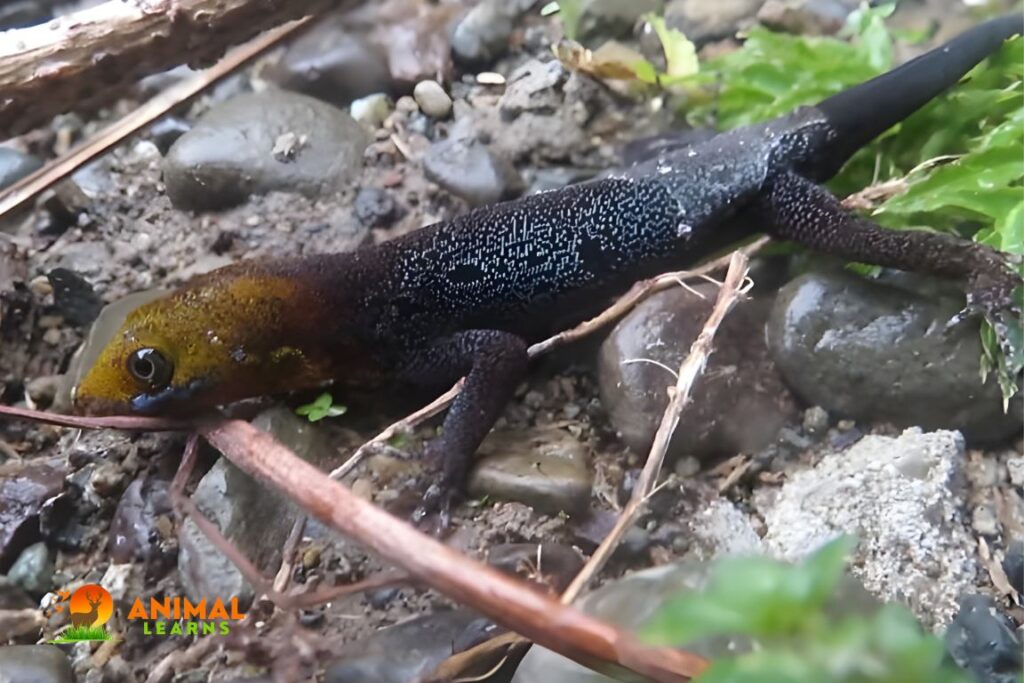
The yellow-headed gecko, as the name suggests, is a vibrant tiny reptile that is distinguished by, you got it, its brilliant yellow head! It’s crucial to remember that the species exhibits significant levels of sexual dimorphism.
The rest of its body is a drab, mottled gray or brown, but its head is a dazzling yellow or orange with faint blue markings around the eyes. Instead of having a yellow tinge, female yellow-headed geckos usually have heads that are a more consistent shade of light brown or tan. Male and female lizards may typically be distinguished easily when they are around six months old.
In addition to Central and South America, the islands of Jamaica, Hispaniola, and Cuba are home to the yellow-headed gecko. Like other Florida geckos, it has been identified as an invasive species in the United States.
It is mostly found in the country’s hottest and muggiest regions, including Florida’s keys. The tiny, razor-sharp claws of the yellow-headed gecko are similar to those of the Florida-dwelling Eublepharidae family of geckos.
Tropical House Gecko (Hemidactylus mabouia)

The next species on the list of geckos found in Florida is the widely distributed tropical house gecko. This species was once found in a few Sub-Saharan African countries, including Tanzania, Zimbabwe, and Uganda.
These hardy, adaptable lizards have made their home in the Caribbean and the warmer, more humid regions of all three Americas (North, Central, and South). From nose to tail, tropical house geckos often reach lengths of three to five inches.
Their bodies have patterns of speckled gray, black, and dark brown over pale brown or tan skin. Like other Florida geckos, its eyes are bulbous and protrude with vertical, slit-shaped pupils.
Ashy Gecko (Sphaerodactylus elegans)

The Ashy gecko, at its juvenile development stage, is a beautiful little lizard with horizontal stripes of darker gray and a primary body hue of light gray. As the gecko ages, these stripes grow thinner and more scattered. They eventually start to resemble random markings and tiny dots.
Its bright tail, however, is this lizard’s most remarkable characteristic. Because ashy geckos do not display sexual dimorphism, their tails are very colorful in both sexes. Usually, they are fiery red or soothing blue in color.
Unfortunately, much like the previously mentioned juvenile string pattern, the geckos’ insane neon tail color likewise becomes considerably more subdued as they become older.
The Ashy gecko was introduced to South Florida in the 1920s, despite being native to Cuba and Hispaniola. Today, the species still flourishes in the state because of its near-tropical climate.
It presently exists in two subspecies, one of which was brought to Florida and is doing well there.
White-Spotted Wall Gecko (Tarentola annularis)
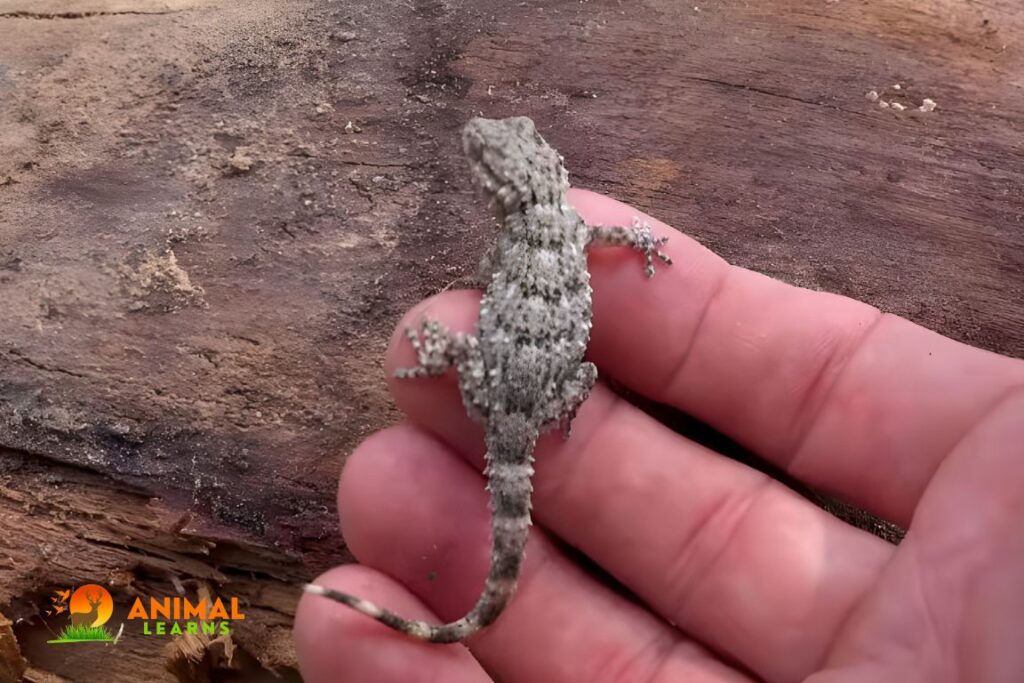
Among the diverse geckos in Florida species, the White-Spotted Wall Gecko stands out for its captivating patterns and remarkable climbing abilities. The white-spotted wall gecko, often referred to as the ringed wall gecko, originated in northern Africa.
Particularly sizable native populations can be found in Ethiopia and Egypt. The precise date and method of human introduction of these geckos to the US are uncertain. However, we are aware that the species has spread to California and Arizona in addition to Florida.
The white-spotted wall gecko lives up to its name; it is mostly pale yellowish-tan with numerous small, erratic white dots. The foot and belly of the lizard are also a very pale yellow or white hue. Its tail has a somewhat keeled outward look due to the scales.
The white-spotted gecko, which is another bigger species on our list, is normally 6 to 8 inches long. In addition to being somewhat broader in the skull, males are often heavier and longer than girls.
Make careful to keep a safe distance from any geckos you come across in the wild. When threatened, white-spotted geckos may be rather aggressive, and if handled, they will bite in defense.
Flat-Tailed House Gecko (Hemidactylus platyurus)
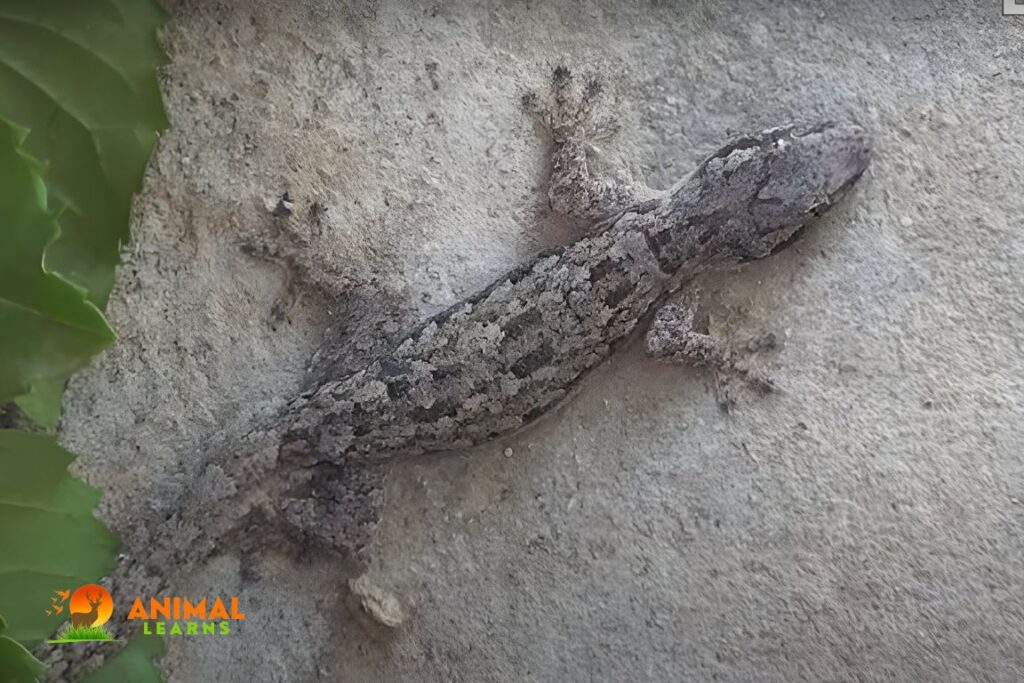
Given that its natural habitats are mostly in Southeast Asia, this long, thin gecko is sometimes occasionally referred to as the Asian house gecko. Similar to almost all of the lizards on this list, this species is native to South Florida.
This gecko falls midway in the center of the size spectrum. The typical length of a flat-tailed house gecko is between 4 and 6 inches. As its name implies, it has a relatively thin and flat body and tail.
Its body is mostly light gray, with tan, brown, and dark grey patterns scattered throughout. The lizard’s sophisticated camouflage is facilitated by these marks, as it mixes in perfectly with the leaf litter and tree bark.
Strangely enough, this species has gained popularity in the pet sector, especially with novice reptile enthusiasts searching for a low-maintenance scaly friend. Flat-tailed house geckos are cheap, need little maintenance, and may live very peacefully in relatively tiny cages, despite their poor handling tolerance.
It is frequently mistaken for other house geckos, including the Mediterranean and tropical house geckos, due to their similar size and look.
Tokay Gecko (Gekko gecko)
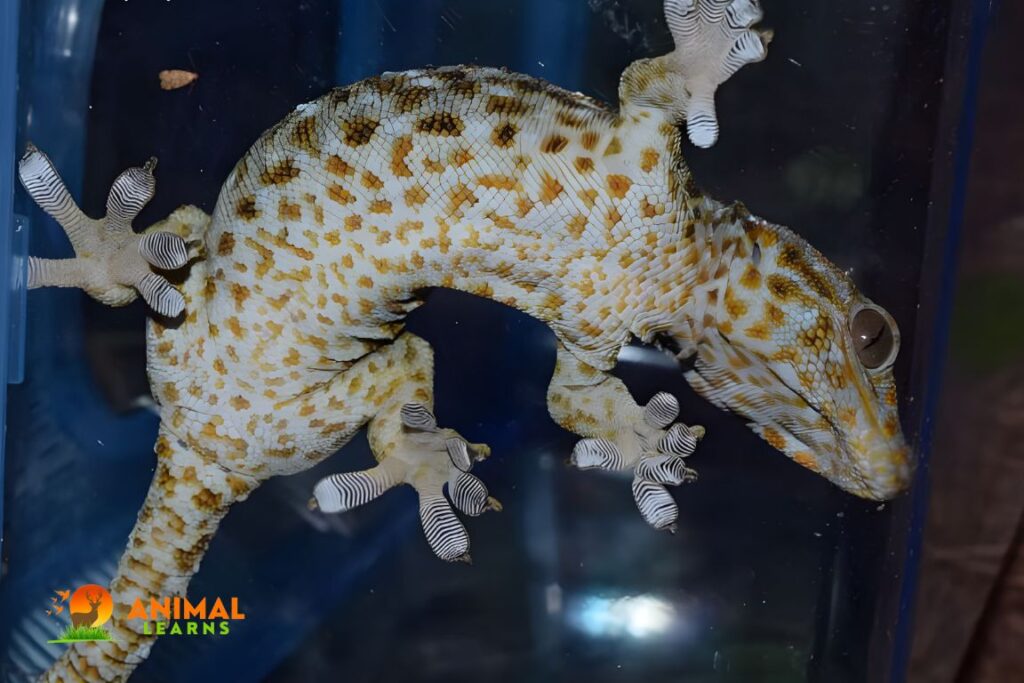
The strangely neon-colored and infamously grumpy tokay gecko rounds off our list of Florida’s most amazing geckos. Funny enough, the species’ loud, cackling mating cry, “To-kay!” is how males often find female partners and gives rise to the species’ popular moniker.
Originating throughout most of the Middle East and Asia, namely in nations like India, Nepal, Thailand, Malaysia, and Indonesia, this amazingly colorful lizard is endemic to these regions.
Naturally, it has also formed sizable colonies in Hawaii and South Florida. However, the tokay gecko faces threats from habitat loss in both of these non-native places.
The Tokay gecko is a stunning, huge, and very threatening reptile in terms of looks! It is a formidable creature with enormous, protruding eyes, bright orange and blue coloring, and a large mouth full of small, sharp fangs.
Some adult Tokay geckos are as long as 15 inches, although most average 10 to 12 inches! It is the third-largest gecko in the world at the moment.
Kayas are quite territorial, aggressive, and often irritated despite being nocturnal and solitary animals. Its bite is extremely painful and forceful! It has gained considerable popularity among knowledgeable reptile keepers in the exotic pet trade, despite its grumpy disposition.
Mediterranean House Gecko (Hemidactylus turcicus)

1.5 to 2.5 inches in length. The eyes are big and spherical with fixed eyelids, and the pupils are vertical.
For concealment, this species has two color phases. Patches of gray or brown tone and coloration ranging from light pink to pale yellow or white. The coloration turns gray or brown, hiding the spots on the back.
You may be shocked to learn that the most common and numerous gecko in Florida is NOT a native species! Florida was first exposed to the Mediterranean House Gecko through imported plants that carried their egg clutches. Their number swiftly surpassed that of any of our native geckos due to their adaptability to so many different habitats!
Even though Mediterranean House Geckos are nocturnal creatures, you may still locate them. Because they are regarded as “urbanized” animals, they are content to live both inside your home and in the wild!
Bibron’s Thick-Toed Gecko (Chondrodactylus bibronii)
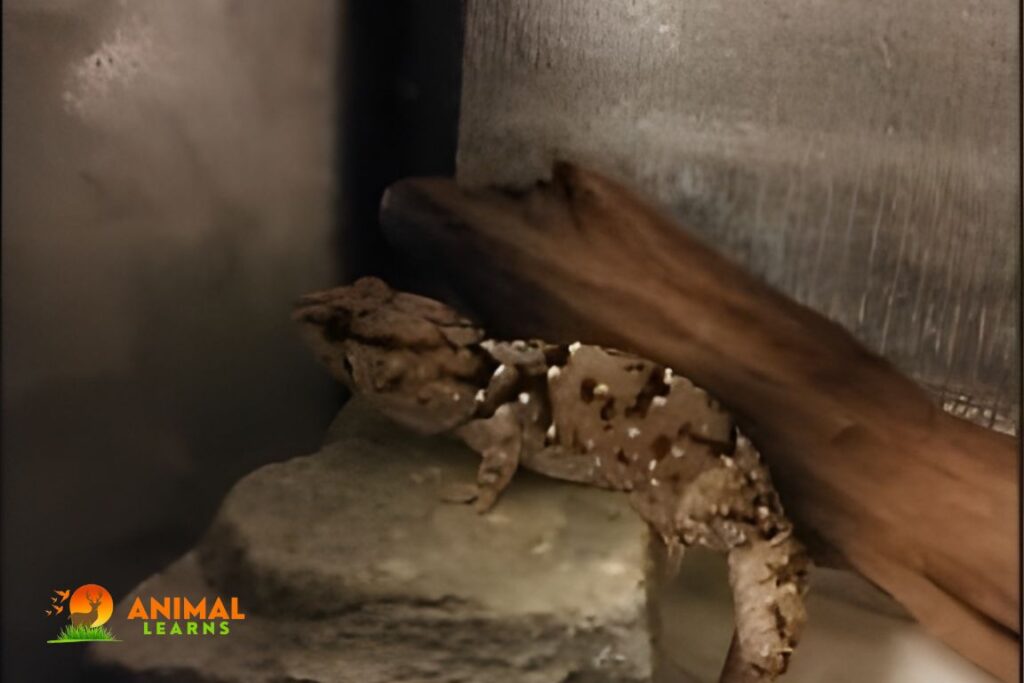
The Bibron’s thick-toed gecko, named for French herpetologist Gabriel Bibron, is sometimes occasionally referred to as just the Bibron’s gecko or Bibron’s sand gecko.
Namibia and South Africa, two nations in southern Africa, are its native lands. It has been brought to the US, though, much like the majority of the other geckos on this list.
At the moment, South Florida is home to the biggest population of Bibron’s geckos. Being a nocturnal and very arboreal animal, it spends much of its days quietly hiding amid the thick undergrowth in the hot, humid woods it usually lives in.
It opens its huge pupils to let in as much light as possible as it wakes up to hunt at night. It has outstanding night vision.
One of the bigger and bulkier lizards on this list is the Bibron’s gecko. It’s also often among the biggest geckos in Florida! Female geckos are smaller than males in the genus, with adult specimens typically reaching lengths of 6 to 8 inches.
Its striped black, brown, and gray coloring is quite similar to that of tree bark. Its robust, broad toes make it ideal for climbing, as the name would imply.
Florida Reef Gecko
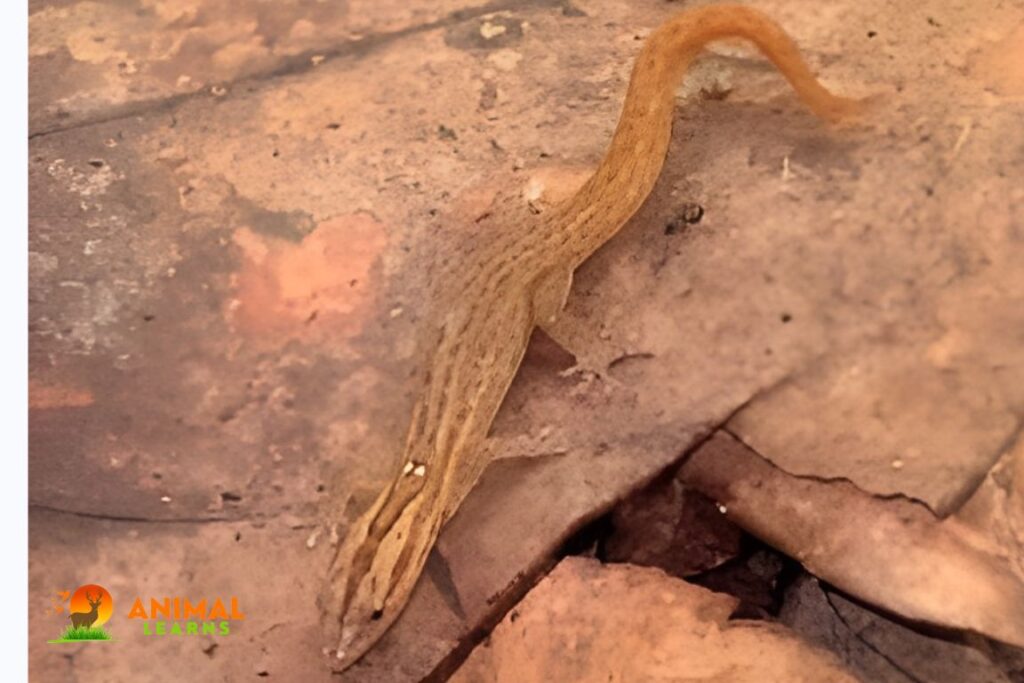
Our small reef gecko, often called the brown-speckled sphaero or the Florida reef gecko, is the only species on our list that is endemic to Florida.
It is indigenous to a few Caribbean islands as well. The warm, humid conditions of these tropical locations enable the reef gecko to not only live but also to thrive in relative comfort.
One of Florida’s tiniest reptiles, reef geckos grow to be just around 2 inches long when completely mature. Their tail makes up half of their body length. Their hue is typically tan or brown with deeper brown stripes and patches. They only eat insects as food.
The females are exclusively active after dusk and have three wide stripes on their heads. They frequently appear to be running into hiding behind rubble.
Mourning Gecko (Hemidactylus lugubris)
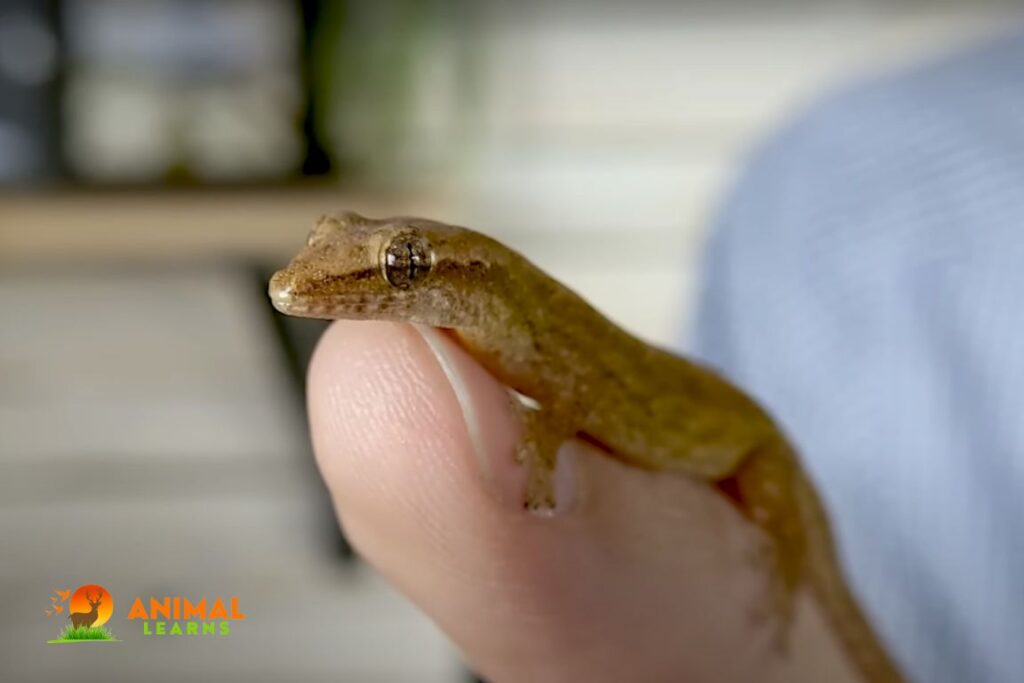
Lepidodactylus lugubris, often known as the Mourning Gecko, is among the most intriguing species of geckos worldwide. The so-called mourning gecko is a parthenogenetic reptile, which means that fertilization is not necessary for the growth and development of its embryo.
This nocturnal creature can adapt to a variety of settings and has a strong community orientation. They live in portions of South and Central America, the Hawaiian Islands, the Cocos Islands, Queensland, Australia, and the Pacific region.
The main food sources for mourning geckos include insects, fruits, and nectar. Nowadays, you can purchase meal packages like Reparshy Super Foods and Crested Gecko that include all the nutrients required for a healthy diet.
Three times a week, you may feed the Crested Gecko diet, which includes ¼-inch crickets, phoenix worms, and roach nymphs. With the exception of phoenix worms, you should sprinkle these meals with calcium powder and vitamin D3.
Golden Gecko

Gekkobadenil, another name for golden geckos in Florida, is found in the humid tropical rainforests of northeastern India and Vietnam. approximately 7 to 8 inches is how big the male develops, while approximately 5 to 6 inches is how big the female grows.
The handling of golden geckos irritates them. They are agitated and prone to stress to some level. You can domesticate them if you handle them appropriately. Conversely, they never think twice to bite if they feel threatened.
As a defensive measure, the gecko may separate its tail, which allows it to flee after confusing and distracting the predator with its twitching tail. In addition, golden geckos have unusual toe pads that allow them to move back and forth on vertical planes.
Like all geckos in Florida, golden geckos are members of the Gekkonidae family. Approximately 2,000 species are known to exist in the world today. The Gekkoninae, Eublepharinae, Dilplodactylinae, Aeluroscalabotinae, and Teratoscincinae are the subgroups that comprise the Gekkonidae family.
The Gekkoninae subdivision, which includes the golden gecko, was further divided into many species by specialists. They make up the largest group in the entire globe.
FAQs
Are geckos native to Florida?
Indeed, Florida is home to a number of native gecko species that thrive in the state’s warm, subtropical environment.
What types of geckos can be found in Florida?
The Mediterranean, Tropical House, and Indo-Pacific geckos are common species in Florida and are each adapted to a distinct type of environment.
Where are geckos typically found in Florida?
Due to their adaptability, geckos may be found in a variety of settings, including both urban and natural settings. They frequently live in residential settings and cling to ceilings and walls.
Are geckos beneficial to the ecosystem in Florida?
Indeed, because they are insectivores, geckos help regulate insect populations. They aid in controlling pests, which maintains the ecosystem’s equilibrium.
Can geckos be kept as pets in Florida?
In Florida, yes, some people own geckos as pets. It’s important to follow the rules, though, as it’s not recommended to release non-native animals back into the wild, and certain species could be invasive.

